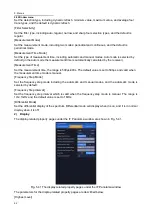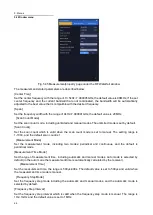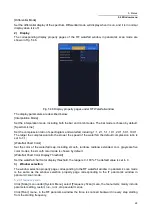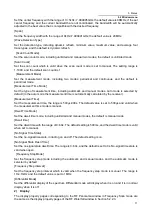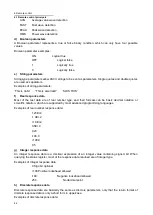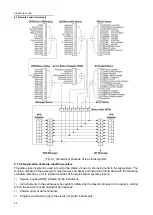
6 Remote control
6.1 Remote control principals
76
The interface adapter automatically matches the appropriate network speed to the link condition.
Normally, the length of the cable connecting the monitoring receiver shall not exceed 100 meters. For
more information about Ethernet, please refer to:
LAN interface introduction:
1) IP address
When remote control of the monitoring receiver is performed via LAN, the physical connection to the
network shall be ensured to be smooth. Set the address to the subnet where the master computer is
located through "IP address" under the Setup->Network Setup interface of the monitoring receiver, for
example: the IP address of the master computer is 192.168.12.0, then the IP address of the monitoring
receiver shall be set to 192.168.12.XXX, where XXX is a value between 1 ~ 255.
Only the IP address is required to establish a network connection, and the VISA addressing string takes
the following form:
TCPIP: : host address: port: : SOCKET
Where:
TCPIP indicates the network protocol used;
The ―host address‖ indicates the IP address or host name of the instrument, which is used to identify
and manage the controlled instrument.
The port identifies the socket port number. For the 3943B monitoring receiver it is 5025;
The SOCKET represents the raw network socket resource class.
Example:
When establishing an original socket connection, the following IP is allowed:
TCPIP::192.1.2.3::5025::SOCKET
Methods of identification of multiple instruments in programmable system
If multiple instruments are connected in the network, the individual IP addresses of the instruments and
the associated resource strings will be used to distinguish them. Host computers identifies the
instruments through their respective VISA resource strings.
2) Socket communication
The TCP/IP protocol connects monitoring receivers in a network via LAN sockets. Sockets are a basic
method used in computer network programming that allows applications using different hardware and
operating systems to communicate in a network. This method enables bi-directional communication
between the monitoring receiver and the computer through a port.
A socket is a specially written software category that defines information necessary for network
communication such as IP addresses and device port numbers, integrating some basic operations in
network programming. Sockets can be used after installing packaged libraries in the operating system.
Two commonly used socket libraries are the Berkeley socket library for UNIX the Winsock library for
Windows.
The sockets in the monitoring receiver are compatible with Berkeley sockets and Winsock through the
Application Program Interface (API). In addition, it is also compatible with other standard socket APIs.
When monitoring the receiver through SCPI command control, the socket program established in the
program issues commands. The socket port number of the monitoring receiver is fixed to 5025.
6.1.2 Message
The messages transmitted on the data cable are separated into the following two categories:
Tip
Содержание 3943B
Страница 2: ...3943B Monitoring Receiver User s Manual Ceyear Technologies Co Ltd...
Страница 4: ......

